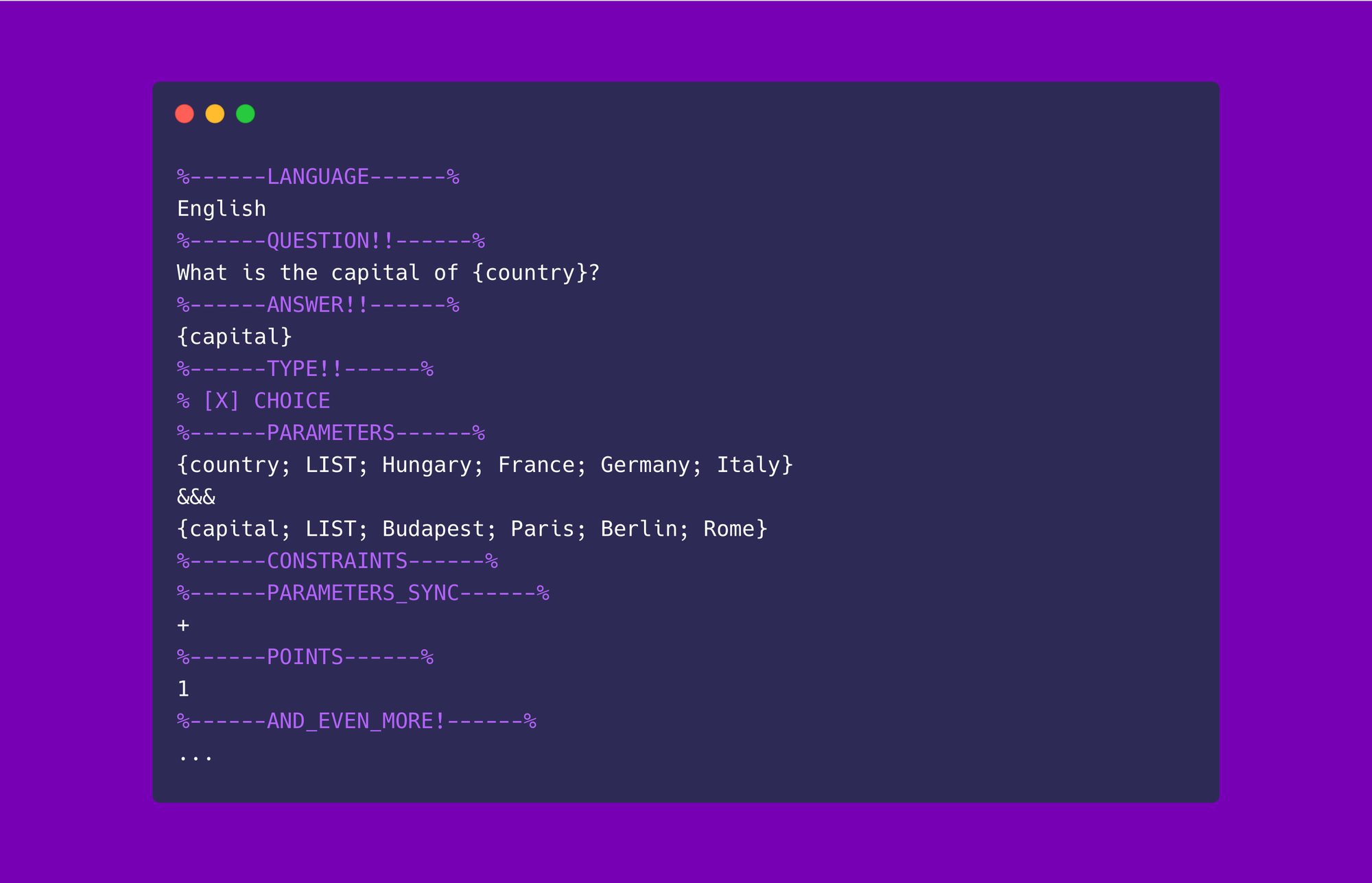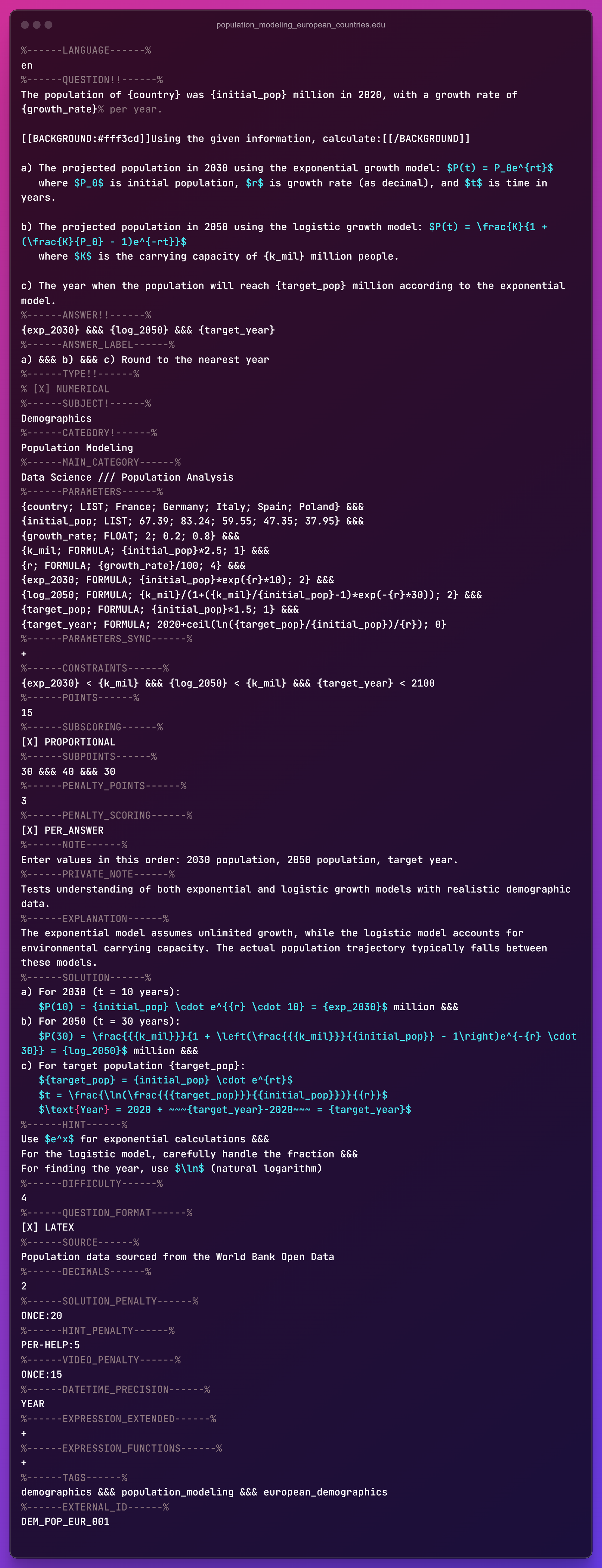The .EDU Format: EduBase's Bridge to the Future of Assessments
Rethinking assessment formats for the age of AI-assisted education.

The ability to create, manage, and scale assessment content efficiently has become crucial in the rapidly evolving landscape of EdTech. Today, we're excited to introduce the .edu file format – a powerful yet elegantly simple solution that's been powering EduBase's assessment capabilities for many years and is now perfectly positioned for the era of AI-assisted education.
What is the .edu format?
The .edu file format is a text-based representation of almost any educational assessment content (quiz or exam question) that combines human readability with machine processability. Unlike complex technical (e.g., XML) schemas or proprietary formats, .edu files are:
- Purely text-based: Simple to create, edit, and maintain with any text editor
- Human-friendly: Readable and intuitive, not cluttered with technical markup or indentations
- Comprehensive: Supports all features available in the EduBase UI
- Portable: Easy to share, version control, and integrate into any workflow
- Multimedia-supported: Supports referenced multimedia, such as images or videos
Examples: From Simple to Sophisticated
Let's look at some specific examples that demonstrate the format's flexibility!
A Simple One

This represents the absolute minimum needed to create a valid question: simple, clear, and effective. Because it's a text question type, the user has to type the answer.
We could capitalize (no pun intended) on the format's parametric capabilities to include more countries for variety. There's no need to have these similar questions represented separately.

When generating this question, EduBase randomly selects a country-capital pair while maintaining their relationship. The synchronized lists ensure that Rome will be the correct answer if Italy is chosen from the first list.
A More Sophisticated One
Bringing the above example a bit further, we can add population growth modeling for European countries, incorporating exponential and logistic growth formulas. This showcases the format's mathematical capabilities:

This example has
- categorization, tagging
- dynamic parameter generation
- formula-based answer calculation
- constraint validation
- LaTeX formatting
- step-by-step hints, solutions
- penalties, and more!
Below is how the question looks like on the EduBase UI, after answering only the third option:

The beauty of it all, is that this is all configurable from a purely text-based file.
Why This Matters in the Age of AI Agents
The .edu format is a significant step as we enter the era of AI-powered education for several reasons:
- AI-Friendly structure: The clear, consistent format makes it ideal for AI agents and LLMs to process, transform (e.g., translate, categorize, enrich, proof-read, ...) and generate similar or entirely new questions
- Scalable content creation: Systems can efficiently generate as many variations as we need while maintaining the same standards
- Parameterization: Built-in support for dynamic question generation, which aligns perfectly with creating a personalized learning experience
- Version control integration: Being text-based, it works effectively with git and other version control systems, which can be essential for managing large-scale content
Comparison with Other Formats
Several question formats exist in the EdTech space, however, most were designed before the era of AI and advanced assessment needs. Let's examine how .edu compares to existing standards!
QTI (Question & Test Interoperability)
While QTI offers broad platform compatibility, the XML structure makes it quite a challenge for most humans to read and write directly. The .edu format prioritizes human readability but maintains machine processability at the same time.
GIFT & Aiken
These formats prioritize simplicity but at the cost of functionality. It's perfect for basic multiple-choice questions, but they can't handle the complex assessment scenarios that modern education demands.
The .edu format, on the other hand, was designed to bridge these gaps with human readability, advanced features and AI-ready structure for future innovations.
The below summarizes some of the key aspects:
| Feature | .edu | QTI | Excel/CSV | GIFT | Aiken |
|---|---|---|---|---|---|
| File Format | Plain text with sections | XML-based | Spreadsheet | Plain text | Plain text |
| Human Readability | ✅ High (section-based) | ⚠️ Medium (XML structure) | ✅ High (tabular) | ✅ High (simple syntax) | ✅ Very High (extremely simple) |
| Question Types | ✅ 16+ types and counting, including advanced STEM | ⚠️ Limited to standard types | ⚠️ Basic types | ⚠️ Basic types | ❌ Multiple-choice only |
| Parameter Support | ✅ Extensive (as of now: FIX, INTEGER, FLOAT, FORMULA, LIST, PERMUTATION) | ❌ Limited | ❌ No | ❌ No | ❌ No |
| Mathematical Support | ✅ Advanced (LaTeX, expressions, matrices) | ⚠️ Basic | ⚠️ Basic | ⚠️ Basic | ❌ No |
| Scoring Options | ✅ Comprehensive (partial credit, penalties, assistance deductions) | ⚠️ Basic | ⚠️ Basic | ⚠️ Basic | ❌ Single correct answer only |
| Media Support | ✅ Images, video, audio, attachments | ✅ Multimedia | ⚠️ Limited | ⚠️ Limited | ❌ No |
| Metadata | ✅ Extensive (categories, tags, notes) | ✅ Good | ⚠️ Basic | ❌ Minimal | ❌ None |
| Platform Support | EduBase-specific | ✅ Wide | ✅ Wide | Moodle-focused | Moodle-focused |
Getting Started 🚀
Ready to explore the .edu format? We've got you covered:
- 📚 Comprehensive Developer Documentation
- 📖 Detailed Format Specification (PDF)
- 📝 Sample .edu File
- ✨ Sample Excel Spreadsheet
- For batch uploading, hundreds of questions
The Path Forward
We developed the .edu format because we recognized early that the future of any assessment requires both structure and adaptability. After a decade of battle-testing our implementation across universities, companies, educational research and global events, we've seen how a thoughtfully designed format can bridge the gap between rigor and the emerging AI capabilities.
This isn't about replacing human judgment – it's about augmenting it with tools that scale without compromising quality.
For those leading educational institutions or developing edtech, the question isn't whether to embrace AI-ready assessment systems, but how to implement them responsibly. The .edu format represents our contribution to this challenge, refined through years of real-world application and continuous iteration.
The future of assessments is already unfolding. Those who recognize the shift will be best positioned to deliver the experiences that coming generations deserve – and expect.
With the .edu format, you can tap into that today.
Curious? Talk to us.
Book a demo here: https://www.edubase.net/page/contact:demo
